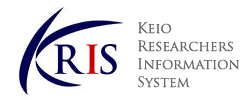-
Affiliation
-
Graduate School of Science and Technology Graduate school of Science and Technology ( Yagami )
-
Position
-
Project Professor (Non-tenured)
-
E-mail Address
-

-
Telephone No.
-
+81-44-580-1576

KEIO RESEARCHERS INFORMATION SYSTEM |
Details of a Researcher
このページはJavascriptを使用しています。すべての機能を使用するためにはJavascript を有効にする必要があります。
Tomono, Takao
|
|
|
Bachelor's degree from the University of Tsukuba in 1984. Ph.D. degree in quantum optics from Keio University in 1998. Since 1984, he has worked at Sharp Corporation for 5 years, Fuji Xerox for 11 years, Samsung Electronics for 3.5 years, and Toppan Holdings for 20 years, before starting work at Keio University in December 2023.During this time, in addition to research, he was also involved in management and business promotion as the head of the company's corporate planning department for over three years. Prior to 2013, he worked in the field of photonics, quantum optics, and semiconductor/microfabrication research. Since 2013 he had been working on computer vision (optical metrology) and since 2018 on quantum information (quantum machine learning, quantum optics).
Products he has developed include TFT-driven printer heads for A0 size printers, lens sheets for rear projection televisions, and medical microneedles.
Academic societies: Member of IEEE Senior Member (Computer Society, Photonics Society), Japan Society for Artificial Intelligence (JSAI), Japan Society of Applied Physics (JSAP), and Optical Society of Japan (OSJ).
Committee activities: Concurrently serves as a committee member for several international conferences. Ai-map committee member of JSAI.
I currently conduct 1-2 peer-reviewed papers per month (machine learning and quantum machine learning).
Keio University, Graduate School of Media and Governance, Project Professor
Keio University, Graduate School of Science and Technology, Project Professor
University of Tsukuba, College of Engineering Sciences, Third Cluster of Colleges
University, Other, Doctoral course
Ph.D., Keio University, Dissertation, 1998.02
Study on Molecular Orientation and Nonlinear Optical Properties of Cyclobutendione-based Organic Materials
Natural Science / Mathematical physics and fundamental theory of condensed matter physics (Quantum AI)
Manufacturing Technology (Mechanical Engineering, Electrical and Electronic Engineering, Chemical Engineering) / Electron device and electronic equipment (Photonic chip)
Informatics / Intelligent robotics (Machine larning)
Photonic chip
Micro Fabrication
machine learning
quantum AI
Quantum photonics
quantum AI,
quantum photonics,
AI Problems Map and Business Application of AI Map
吉岡健, 友野孝夫, 友野孝夫, 一般社団法人 人工知能学会, 2023.07
有機非線形光学材料の開発と応用
中西, 八郎, 小林, 孝嘉, 中村, 新男, 梅垣, 真祐, シーエムシー, 2001.08, Page: xiii, 558p
Scope: 7.シクロブテンジオン環を有する新しい有機非線形光学材料
The discriminative ability on anomaly detection using quantum kernels for shipping inspection
Takao Tomono and Kazuya Tsujimura
epj Quantum Technology (Springer Science and Business Media LLC) 12 ( 1 ) 2025.03
Research paper (scientific journal), Joint Work, Lead author, Corresponding author, Accepted, ISSN 2662-4400
Liquid crystal waveguide film and its application to smart glasses
Takao Tomono, Rumiko Yamaguchi
Discover Electronics (Springer Science and Business Media LLC) 1 ( 1 ) 2024.06
Lead author, Last author, Corresponding author, Accepted, ISSN 2948-1600
Quantum kernel learning Model constructed with small data
T Tomono, K Tsujimura
arXiv preprint arXiv:2412.00783 2024
Lead author, Last author, Corresponding author, Accepted
Discover Electronics
T Tomono, R Yamaguchi
2024
Lead author, Last author, Corresponding author, Accepted
Quantum Kernels for Difficult Visual Discrimination
Takao Tomono, Kazuya Tsujimura, Takumi Godo
Proceedings - 2023 IEEE International Conference on Quantum Computing and Engineering, QCE 2023 (Proceedings - 2023 IEEE International Conference on Quantum Computing and Engineering, QCE 2023) 2 262 - 263 2023
Research paper (international conference proceedings), Lead author, Corresponding author, Accepted
AI Problems Map and Business Application of AI Map
吉岡健, 友野孝夫, 友野孝夫
人工知能 (一般社団法人 人工知能学会) 38 ( 4 ) 529 - 538 2023.07
Last author, Corresponding author, ISSN 2188-2266
Inspection trail with factory data on quantm kernel learning
TOMONO Takao, NATSUBORI Satoko
Proceedings of the Annual Conference of JSAI (The Japanese Society for Artificial Intelligence) JSAI2023 3Xin475 - 3Xin475 2023
Lead author, Last author, Corresponding author, ISSN 2758-7347
Performance evaluation of quantum kernel machine learning
TOMONO Takao, NATSUBORI Satoko, IMAIZUMI Katsumi
Proceedings of the Annual Conference of JSAI (The Japanese Society for Artificial Intelligence) JSAI2022 4Yin250 - 4Yin250 2022
Lead author, Last author, Corresponding author, ISSN 2758-7347
Efficient Optimization Method Using Tensor Networks for Circuit to Generate non-Gaussian States
永井隆太郎, 友野孝夫
Optics & Photonics Japan講演予稿集(CD-ROM) 2022 2022
Lead author, Last author, Corresponding author
Photonics quantum computing using tensor network 2: Application for real problems
永井隆太郎, 友野孝夫
応用物理学会春季学術講演会講演予稿集(CD-ROM) 69th 2022
Research paper, summary (national, other academic conference), Last author, Corresponding author, ISSN 2436-7613
量子機械学習による音声異常検知の試み -工場の導入を目指した基礎 検討-
Takao Tomono, Kazuya Tsujimura
[Domestic presentation] 2025年第72回応用物理学会春季学術講演会,
Oral presentation (general)
Inspection trail with factory data on quantm kernel learning
TOMONO Takao, NATSUBORI Satoko
Proceedings of the Annual Conference of JSAI,
The Japanese Society for Artificial Intelligence
Efficient Optimization Method Using Tensor Networks for Circuit to Generate non-Gaussian States
永井隆太郎, 友野孝夫
Optics & Photonics Japan講演予稿集(CD-ROM),
Performance evaluation of quantum kernel machine learning
TOMONO Takao, NATSUBORI Satoko, IMAIZUMI Katsumi
Proceedings of the Annual Conference of JSAI,
The Japanese Society for Artificial Intelligence
Photonics quantum computing using tensor network 2: Application for real problems
永井隆太郎, 友野孝夫
応用物理学会春季学術講演会講演予稿集(CD-ROM),
Anomaly detection system, learning device, anomaly detection device, learning method, anomaly detection method, and program
Date applied: 特願2025-031708 2025.02
Patent
Optical Switch
Date applied: 特願2025-020126 2025.02
Patent
Power generator, and power generation method
Date applied: 2018.07
Date announced: 特開2020022222-A 2020.02
Patent
2017032409
Date applied: 2015.07
Date announced: 特開2017032409 A 2017.02
Patent
Stereoscopic image display body
Date applied: 2013.11
Date announced: 特開2015099187-A 2015.05
Patent
量子カーネルを活用した高精度な異常検知技術を実現 ―少量データでの量子機械学習の有効性を実証し、製造DXを推進―
(日本経済新聞、PR TIMESほか) , 2025.03
IEEE computer society,
IEEE Photonics Society,
The Japanese Society for Artificial Intelligence,
IEEE,
The Optical Society of Japan,
Program committee, Gavriel Salvendy International Symposium on Frontiers in Industrial Engineering Purdue Quantum AI (PQAI)
Program committee, QAIO
IEEE SA Standard for Quantum Computing Architecture, IEEE
Comittee of AI map, The Japanese Scoiety for artificial intelligence
Workshop on Flexible electronics, International Display Workshop